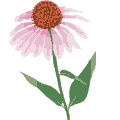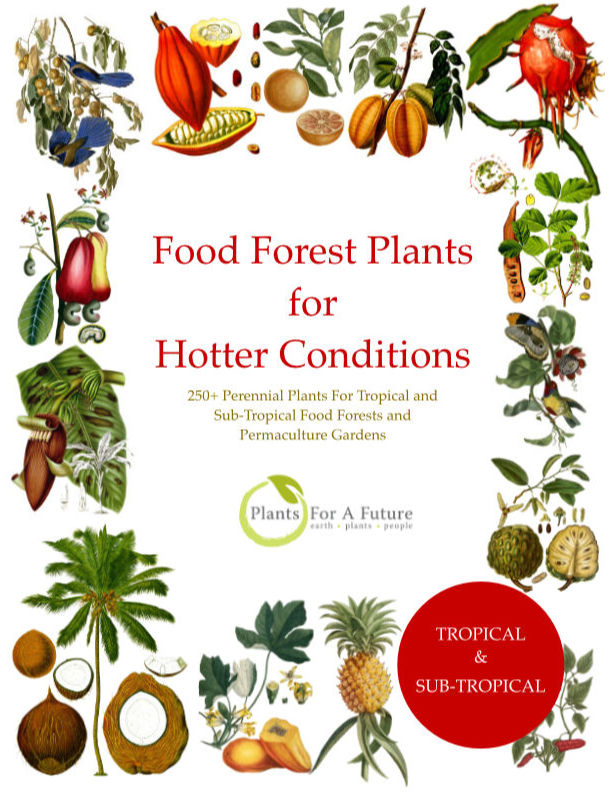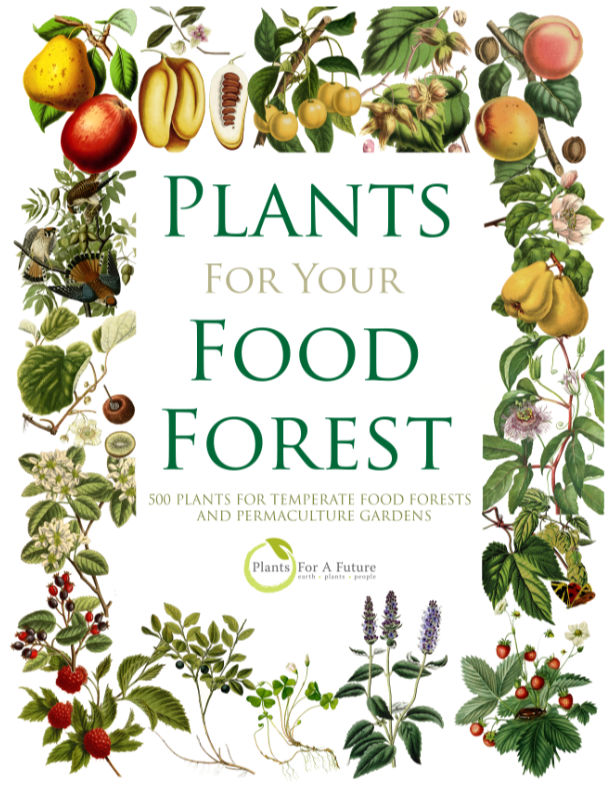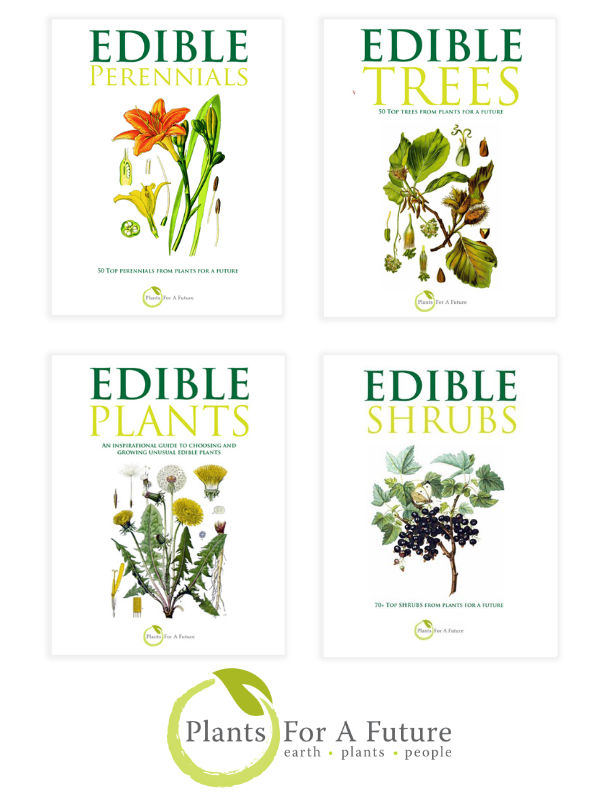Translate this page:
Summary
Echinacea species
Echinacea (E. angustifolia, E. purpurea and E. pallida) is one of the world's most important medicinal herbs. Research shows that stimulating the immune system can raise the body's resistance to bacterial and viral infections. It is also an antibiotic and helps to relieve allergies. The leaf, flower, and root are used. Plants in this genus were probably the most frequently used of all North American Indian herbal remedies.
Echinacea attracts butterflies and beneficial insects, including parasitic wasps. It is a shelter plant for beneficial insects and a wildlife Food for seed-eating birds—a favourite of the American Goldfinch. Echinacea is a pioneer plant helping to reestablish overused or damaged land. Once established, this species can tolerate prolonged dry conditions.
Harvesting: Roots in late autumn. Flowers in summer when they are fully open.
Physical Characteristics

 Echinacea pallida is a PERENNIAL growing to 1 m (3ft 3in) at a medium rate.
Echinacea pallida is a PERENNIAL growing to 1 m (3ft 3in) at a medium rate.
See above for USDA hardiness. It is hardy to UK zone 5 and is not frost tender. It is in flower from August to September. The species is hermaphrodite (has both male and female organs) and is pollinated by Insects. The plant is self-fertile.
It is noted for attracting wildlife.
Suitable for: light (sandy), medium (loamy) and heavy (clay) soils and prefers well-drained soil. Suitable pH: mildly acid, neutral and basic (mildly alkaline) soils. It cannot grow in the shade. It prefers moist soil.
UK Hardiness Map
US Hardiness Map
Synonyms
Brauneria pallida. Rudbeckia pallida.
Plant Habitats
Cultivated Beds;
Edible Uses
References More on Edible Uses
Medicinal Uses
Plants For A Future can not take any responsibility for any adverse effects from the use of plants. Always seek advice from a professional before using a plant medicinally.
Adaptogen Alterative Antiseptic Appetizer Depurative Diaphoretic Digestive Sialagogue
Urinary
Plants in this genus were probably the most frequently used of N. American Indian herbal remedies, though this species is considered to be less active than E. angustifolia[222]. They had a very wide range of applications and many of these uses have been confirmed by modern science. The plant has a general stimulatory effect on the immune system and is widely used in modern herbal treatments[222]. There has been some doubt over the ability of the body to absorb the medicinally active ingredients orally (intravenous injections being considered the only effective way to administer the plant), but recent research has demonstrated significant absorption from orally administered applications[222]. In Germany over 200 pharmaceutical preparations are made from Echinacea[222]. The roots and the whole plant are considered particularly beneficial in the treatment of sores, wounds, burns etc, possessing cortisone-like and antibacterial activity[222]. The plant was used by N. American Indians as a universal application to treat the bites and stings of all types of insects[213]. An infusion of the plant was also used to treat snakebites[213]. The plant is adaptogen, alterative, antiseptic, depurative, diaphoretic, digestive, sialagogue[4, 21, 61, 165, 213]. It is harvested in the autumn and dried for later use[238]. The German Commission E Monographs, a therapeutic guide to herbal medicine, approve Echinacea for common cold, cough and bronchitis, fevers and cold, urinary tract infections, inflammation of the mouth and pharynx, increase resistance to infection, wounds and burns (see [302] for critics of commission E).
References More on Medicinal Uses
The Bookshop: Edible Plant Books
Our Latest books on Perennial Plants For Food Forests and Permaculture Gardens in paperback or digital formats.

Edible Tropical Plants
Food Forest Plants for Hotter Conditions: 250+ Plants For Tropical Food Forests & Permaculture Gardens.
More

Edible Temperate Plants
Plants for Your Food Forest: 500 Plants for Temperate Food Forests & Permaculture Gardens.
More

More Books
PFAF have eight books available in paperback and digital formats. Browse the shop for more information.
Shop Now
Other Uses
Agroforestry uses:
Echinacea can be used as a pollinator plant, providing nectar for beneficial insects. It can also help improve soil health and stability.
1. Nectary - Flowers rich in nectar and pollen:
Yes – Echinacea flowers are rich in nectar and pollen, making them attractive to a variety of pollinators, including bees and butterflies.
2. Wildlife - Food (Fruit, Seeds, Leaf litter, Shelter, Nesting, Roosting):
Yes – The seeds of Echinacea are eaten by birds and other wildlife. The plant also provides cover and habitat for beneficial insects.
3. Invertebrate Shelter (Overwintering sites, Leaf litter, Groundcover):
Yes – Echinacea can provide overwintering sites for beneficial insects in its leaf litter. The stems can also serve as shelter during the winter months.
4. Pest Confuser (Smell):
No – Echinacea does not have a strong aromatic quality that would effectively confuse pests.
Special Uses
References More on Other Uses
Cultivation details
Succeeds in ordinary garden soil[111] but prefers a deep, rich loam with plenty of leaf mould [1] and a sunny position[175]. Slugs love this plant[K]. Echinacea roots are typically harvested in late autumn, while the flowers can be harvested in summer (June to August) when they are fully open.
Echinacea usually flowers from mid-summer to early autumn. Echinacea has a moderate growth rate, taking about 2-3 years to reach full maturity and flowering size. Echinacea species are generally self-fertile.
References Carbon Farming Information and Carbon Sequestration Information
Temperature Converter
Type a value in the Celsius field to convert the value to Fahrenheit:
Fahrenheit:
The PFAF Bookshop
Plants For A Future have a number of books available in paperback and digital form. Book titles include Edible Plants, Edible Perennials, Edible Trees,Edible Shrubs, Woodland Gardening, and Temperate Food Forest Plants. Our new book is Food Forest Plants For Hotter Conditions (Tropical and Sub-Tropical).
Shop Now
Plant Propagation
Seed - sow March/April in a greenhouse and only just cover the seed[175, K]. Diurnal temperature fluctuations aid germination[175]. The seed usually germinates in 10 - 21 days at 25°c[175]. Prick out the seedlings into individual pots once they are large enough to handle and grow them on in the greenhouse for the first summer. Plant them out in the late spring or early summer of the following year and give them some protection from slugs at least until they are established[K]. Division in spring or autumn[111]. Larger clumps can be replanted direct into their permanent positions, though it is best to pot up smaller clumps and grow them on in a cold frame until they are rooting well. Plant them out in the spring. Root cuttings, October in a frame[200].
Other Names
If available other names are mentioned here
Native Range
NORTHERN AMERICA: Canada (Ontario), United States (Indiana, Michigan, Iowa, Kansas (east), Missouri, Nebraska (east), Illinois, Oklahoma (east), Wisconsin, Alabama, Arkansas, Louisiana (n. & w.), Tennessee, Texas)
Weed Potential
Right plant wrong place. We are currently updating this section.
Please note that a plant may be invasive in one area but may not in your area so it’s worth checking.
Conservation Status
IUCN Red List of Threatened Plants Status :

Growth: S = slow M = medium F = fast. Soil: L = light (sandy) M = medium H = heavy (clay). pH: A = acid N = neutral B = basic (alkaline). Shade: F = full shade S = semi-shade N = no shade. Moisture: D = dry M = Moist We = wet Wa = water.
Expert comment
Author
(Nutt.)Nutt.
Botanical References
43200
Links / References
For a list of references used on this page please go here
Readers comment
| Add a comment |
|
If you have important information about this plant that may help other users please add a comment or link below. Only comments or links that are felt to be directly relevant to a plant will be included. If you think a comment/link or information contained on this page is inaccurate or misleading we would welcome your feedback at admin@pfaf.org. If you have questions about a plant please use the Forum on this website as we do not have the resources to answer questions ourselves.
* Please note: the comments by website users are not necessarily those held by PFAF and may give misleading or inaccurate information.
To leave a comment please Register or login here All comments need to be approved so will not appear immediately.
|
Subject : Echinacea pallida
|
|
|